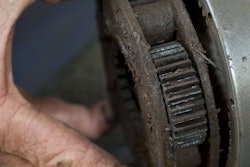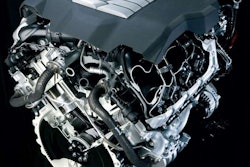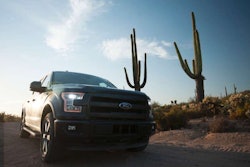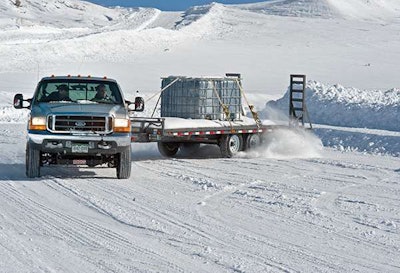 Bringing a jackknifing trailer back in control requires keeping the pickup’s wheels straight while adding throttle to help pull the trailer back in line. Controlled trailer braking comes after the combo is straightened out.
Bringing a jackknifing trailer back in control requires keeping the pickup’s wheels straight while adding throttle to help pull the trailer back in line. Controlled trailer braking comes after the combo is straightened out.
Whether the first snowfall cools the Labor Day festivities or sharpens the smells of Thanksgiving dinner, it signals the change in many Snow Belt landscape contractors’ annual business cycles from moving rocks and dirt to moving ice and snow.
And snow removal is big business. It provides a steady winter income helping area businesses keep driveways and parking lots accessible and safe for their patrons.
That means those who are doing the snow removal are the ones driving in the worst conditions as they go about their work or move compact loaders, side-by-sides and other equipment on trailers from one frozen jobsite to the next.
Veterans owners make the transition from warm-weather driving habits to winter within the first few hours of driving on snow. But employees new to the winter climes, or younger, less experienced drivers aren’t as adept, which can lead to costly incidents.
It’s an intuitional change born from years of experiences and lessons learned.
Here are 10 tips that can help make the transition from summer to winter driving faster, smoother and safer for both newbies and seasoned pickup drivers.
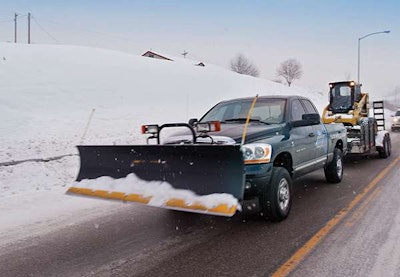 There are several keys to being a good winter driver including adjusting vehicle speed for the conditions, running the proper tires and tire pressures and balancing the trailered load.
There are several keys to being a good winter driver including adjusting vehicle speed for the conditions, running the proper tires and tire pressures and balancing the trailered load.1. Tire pressure
Driving safely on slippery surfaces is all about maximizing traction at all four tire contact points of the truck. It’s critical to keep the tire pressures at the vehicle manufacturer’s recommended psi. Under/over-inflated tires upset vehicle control.
2. Matched tires
Never run mixed tire tread patterns, sizes or tread wear on a vehicle in the winter.
Again, equal traction on the front and rear are critical for vehicle control. New tires on the front and old on the rear will cause the truck to oversteer (rear to slide out); new tires in back, old in front will cause understeer (push, not turn). Replace tires in sets of four.
3. Tire type
The best tires for winter use in areas where heavy snowfall is common are dedicated snow tires.
Snow tires (they carry the mountain snowflake symbol) are made with tread compounds designed to maximize tread flexibility and road contact while driving on snow/ice. All-season and all-terrain tires are marginal. Mud/traction tires are not recommended for snow driving.
 Shocks and suspension components take a beating when subjected to snowplow use. Shocks should be checked annually and the fronts should be replaced at least every 25,000 miles.
Shocks and suspension components take a beating when subjected to snowplow use. Shocks should be checked annually and the fronts should be replaced at least every 25,000 miles.4. About shocks
Worn-out shocks cause instability when the truck encounters dips and bumps, cornering and towing. Instability upsets vehicle balance and control in slick conditions. Replace factory shocks at least every 25,000 miles and aftermarket gas-shocks every 50,000 to be safe. Replace front shocks twice as frequent when using the truck for plowing.
5. Brake or turn
The first lesson in snow driving school is when making a corner, either brake or turn, never both at the same time. Brake in a straight line before the turn, then lift off of the brake and turn the wheel slowly. Smoothness is the key to being a good winter driver.
6. Adjust speed
The biggest mistake when driving on slick roads, especially snow-packed or plowed roads, is driving too fast. Speeding can’t be corrected by braking on snow/ice. That problem is compounded when towing a trailer. How fast is too fast? Test the road surface from time to time when no one is behind or ahead by lightly putting your foot on the brakes to test the slipperiness of the road surface. You’ll know if your speed is appropriate.
 Equipping pickups that work everyday in the snow with dedicated snow tires provides the driver with an added margin of vehicle control and safety.
Equipping pickups that work everyday in the snow with dedicated snow tires provides the driver with an added margin of vehicle control and safety.7. Straighten to turn
If you are trying to make a turn and the truck doesn’t respond, straighten the steering wheel while keeping off of the brakes or throttle. Front tires turned too sharp can’t get traction. They skid instead of roll, creating a “plowing” effect. Straightening the wheel helps regain steering control.
8. Trailer skid control
If the trailer starts to jackknife, accelerate and don’t brake. At the same time, keep the tow vehicle’s wheels straight – don’t
counter-steer in the direction of the sliding trailer. Once the trailer is straight, slowly brake to regain control.
9. Boxing corners
Another winter towing tip is “V-ing off” the corners by braking in a straight line before entering the corner then steering through it, before accelerating out of the corner when the truck and trailer are again in a straight line. Never turn and brake at the same time.
10. Weight balance
Keeping the vehicle (and trailer) balanced at all times is the primary goal for winter driving. When the weight balance on the tires shifts front to rear, or side to side, because of aggressive driving habits, the vehicle control becomes an immediate issue. Accelerate easily. Turn smoothly. Brake lightly.
Driving like you have the proverbial raw egg under your foot is ideal in slick conditions.
Editor’s Note: Bruce Smith is a Senior Editor at Randall-Reilly

